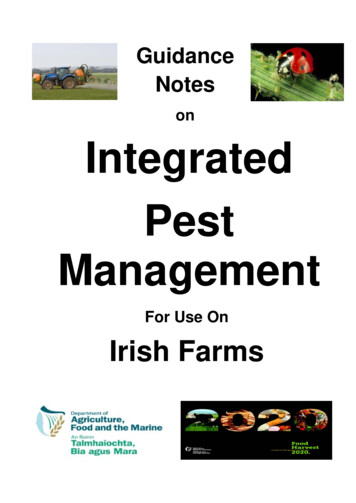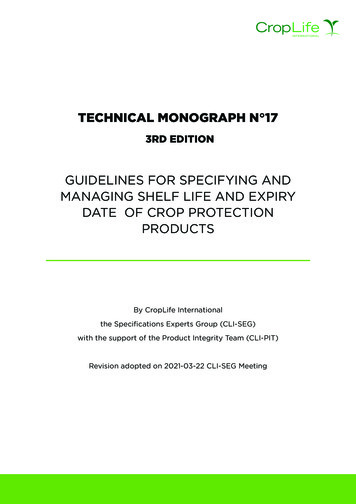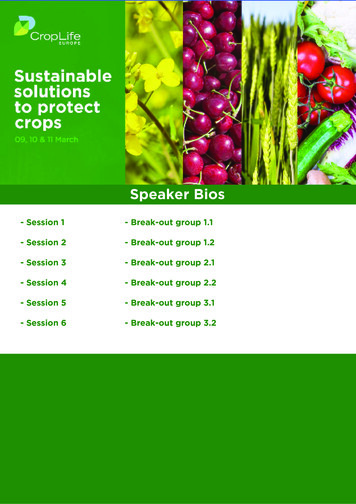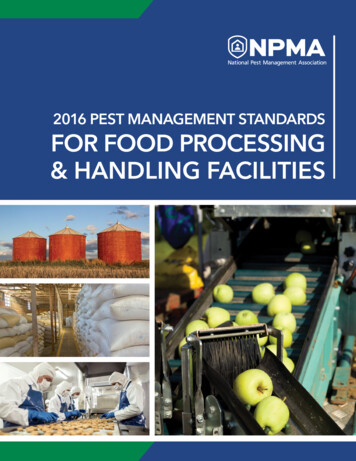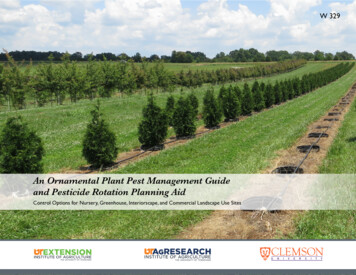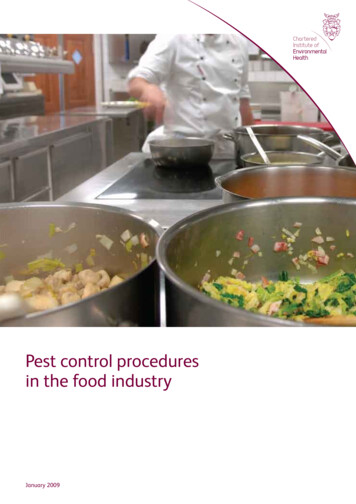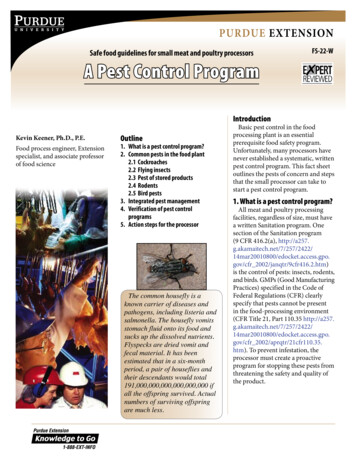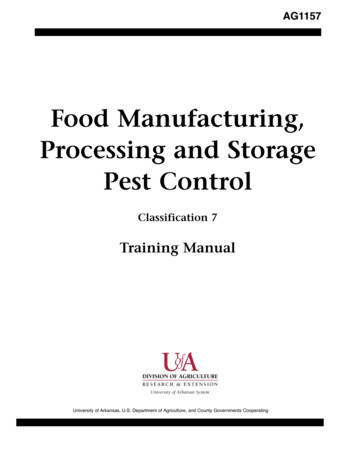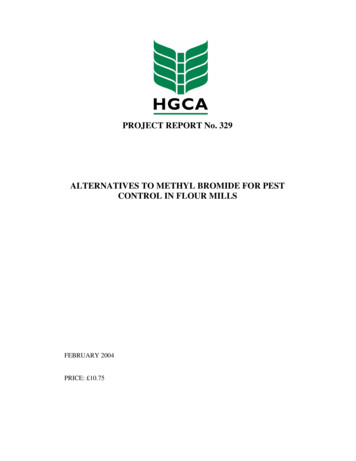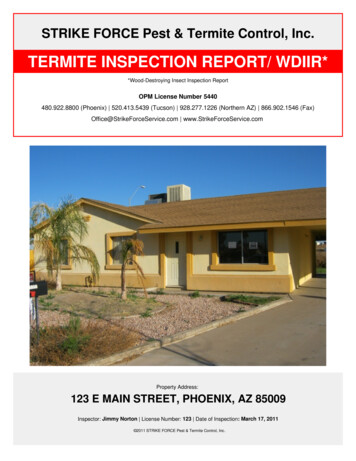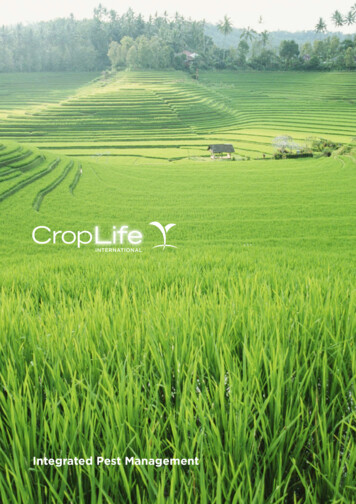
Transcription
Integrated Pest Management1
TA B L E O F C O N T E N T S2CropLife InternationalPolicy on IPMOV E RV I E W3What is IPM?4Why is IPM Important?5Benefits of IPMIPM tionI P M S T R AT E G I E S A N D T O O L S10 Overview11 Setting an Economic Threshold11 Protecting Natural Enemies12 Selecting the Right Products12 Using Products Responsiblyand Safely13 Preventing Pest Resistance toCrop Protection ProductsPLANT SCIENCEINDUSTRY AND IPM14 Overview15 Stewardship and TrainingCASE STUDIES16 Thailand Boosts FruitExports with IPM17 Guatemala PioneersResponsible Use Training17 West Africa Protects Cocoawith Spray Service18 Indian Farmers Benefit fromIPM Training19 Europe Helps ProtectFarmers and Public Health2CROPLIFE INTERNATIONALPOLICY ON IPMCropLife International and its member companiesand associations support sustainable agricultureto produce sufficient, affordable food and fiber in anenvironmentally and socially sensitive manner. Ourgoal is to maintain the natural resource basefor future generations.We are committed to Integrated Pest Management(IPM)—an economically viable, environmentallysound and socially acceptable approach to cropprotection—as defined by the International Code ofConduct on Pesticide Management. It is the missionof our member companies to provide customerswith safe and effective technologies to protectagainst adverse effects caused by pests, diseasesand weeds.Our member companies enable and encouragethe implementation of IPM by developing andpromoting appropriate products and services.We cooperate with partners to develop and testIPM strategies and programs as well as provideeducation and training on the sustainable useof crop protection products. We measure andcommunicate progress within our industry onthe adoption of the principles and values ofthis declaration.
What is IPM?According to the Food and Agriculture Organization (FAO) of theUnited Nations*, IPM means considering all available pest controltechniques and other measures that discourage the developmentof pest populations, while minimizing risks to human health andthe environment.For farmers, IPM is the best combination of cultural, biological andchemical measures to manage diseases, insects, weeds and otherpests. It takes into account all relevant control tactics and methodsthat are locally available, evaluating their potential cost-effectiveness.IPM does not, however, consist of any absolute or rigid criteria. It isa flexible system that makes good use of local resources and thelatest research, technology, knowledge and experience.IPM allows farmersto manage diseases,insects, weeds andother pests in acost-effective andenvironmentallysound way.Ultimately, IPM is a site-specific strategy for managing pests in themost cost-effective, environmentally sound and socially acceptableway. Implementation of IPM lies with farmers, who adopt practicesthey view as practical and valuable to their activities.* I ntegrated Pest Management (IPM) means the careful consideration of all available pest control techniques and subsequent integration ofappropriate measures that discourage the development of pest populations and keep pesticides and other interventions to levels that areeconomically justified and reduce or minimize risks to human health and the environment. IPM emphasizes the growth of a healthy cropwith the least possible disruption to agro-ecosystems and encourages natural pest control mechanisms. (FAO, 2012).3
GLOBALWhyis GLOBALIPM Important?POPULATIONTHIS MEANS FARMERS MUSTIPM PROTOOLTHISTHISMEANSFARMERS MUST IPM PROVIDESIPMPRMEANS FARMERS MUSTFARMERSTOOLS AND STRATEGITOOLGLOBALis on the rise POPULATIONPOPULATIONGLOBAL is on the rise is on the riseINCREASE IPM PROVIDES FARMERSsustainablyOBALTHIS MEANS FARMERS ATEGIESTOINCREASEGLOBALTHIS MEANS FARMERS MUSTIPM PROVIDES FARMERS WITHTIONPOPULATIONPROon existingis on therise GLOBALon existingTOOLSANDSTRATEGIES TOPOPULATIONTOOLSANDSTRATEGIESTOTHIS MEANS FARMERS MUSTIPM PROVIDES FARMERSYIELDSlandandTOOLS ANDWITHSTRATEGIEMEANS FARMERSMUSTlandIPM PROVIDES FARMERSanandis on the rise THISsustainablythereforeonexistingTOOLSAND STRATEGIES ly MAXIMIZEis on the riseso isINCREASEthereforewhileINCREASElandand ablyFOODMAXIMIZEINCREASEduesothereforeis onDEMANDPROPRODUPRODUCTIONon nd looking afterandlandand andFOODsoisand PRODUCTIOthereforePROTECTINGon existingwhiletheenvironmentandthereforeMIlandand thereforeso islandandwhileMINIMIZEBIODIVERSITYandLOFOODso is SES MINIMso is FOOD thereforedue toinsects,so is FOODwhilewhileand lookingafterenvironmentDEMANDBIODIVERSITY g afterFOODto instheenvironmentPROTECTINGdue dueto insects,FOODandlookingafterPROTECTINGDEMAND VERSITYweedsandweeds and diseasthe environmentDEMANDBIODIVERSITYand lookingand lookingafterafterweeds and diseasese riseis POPULATIONon the risethe environmentand lookingtheafterenvironmentGLOBALthe environmentThe demands of a growing world populationTHIS MEANS FARMERS MUSTULATIONfor food and fiber require farmers to produceTHIS MEANS FARMERS MUSTIPM PROVIDES FARMERS WITHANDWITHSTRATEGIES TOIPM PROVIDESTOOLSFARMERSmore crops on existing farmland. To increaseontheriseGLOBALGLOBALALTOOLSANDSTRATEGIES TOTHIS FARMERSMEANSFARMERSIPM PROVIDESTHISMEANSMUSTIPMMUSTIPM PROVIDESFARMERSWITH RMERSMUSTPROVIDESFARMERSWITH FARMERSULATIONthese OOLSANDSTRATEGIESTOINCREASETOOLS AND STRATEGIES TOis onof riseagricultural technologies to minimize croprisetheen theTHISMEANSFARMERSMUSTIPMPROVIDESFARMERS sustainablyTOOLS AND STRATEGIES TOINCREASEsustainablylosses. The challengeistodothiswhileINCREASEINCREASEINCREASEis on the risePRODUCTIONMAXIMIZEMAXIMIZEon existingMAXIMIZEMAXIMIZEYIELDSYIELDSprotecting and on existingPRODUCTIONMAXIMIZEon landexistingYIELDSlandandlandandandand IPMis a big part of thesolution. Increasingly it ndandand developing on existingd thereforeMINIMIZEMINIMIZE andlandMINIMIZEMINIMIZEbeingadoptedin both developedsoissoissoisso ESLOSSESLOSSEScountriesfor long-term, sustainableagricultureFOODMINIMIZEFOOD FOODPROTECTINGdue to insects, MINIMIZEPROTECTINGdue to insects,sois PROTECTINGFOODdue to safeandqualityfooddueto nd edsdiseasesFOODPROTECTINGLOSSESand velihoodsandweeds and diseasesODBIODIVERSITYthe environmentweeds and diseasesPROTECTINGthe environmentthe DEMANDenvironmentdue to insects,and lookingandafterconserves non-renewableresources.looking afterDBIODIVERSITYthe environmentthe environmentweeds and diseasesand looking afterthe environment4
Benefits of IPMIPM provides multiple benefits for society and the environment.It is vital for the long-term future of the plant science industry. I mproved crop profitability due to betterpest control measures and appropriate useof crop protection productsCrop protection companies that integrate IPMprinciples into marketing and customer supportfor their products also stand to benefit from: Stable, reliable and quality crop yields Sustained market share and access Decreased severity of pest infestations Less risk of restrictions or deregistration educed potential for problems ofRpest resistance or resurgence ew opportunities for established andNnovel products, techniques and services I ncreased consumer confidence in the safetyand quality of food and fiber products Longer product lifecycles ecreased resistance of pests to cropDprotection products and biotech plants I ncreased public confidence in, andcredibility of, the crop protection industryIPM ComponentsIPM requires competence in three areas: prevention, monitoring and intervention.PREVENTIONPrevent thebuild-up of pestsIncludes a rangeof practical strategiesthat suit local conditions.MONITORINGMonitor crops for both pestsand natural control mechanismsInvolves scouting for pests(insects, diseases and weeds)to determine if, when and howintervention should occur.INTERVENTIONIntervene when controlmeasures are neededInvolves physical, biologicaland chemical methods to preservethe economic value of crops withminimal effects on the nagecropsdetermineactioninterveneresponsibly5
IPM COMPONENTSPreventionMany aspects of crop management are designed to preventinitial outbreaks of insects, diseases or weeds. Practicalstrategies (outlined below) can be combined and optimizedfor an IPM program. The goal is to prevent pest populationsfrom building up to economically damaging levels.CROP LOCATIONGrowing crops in locations where they are bestsuited to climate, soil and topography providesthem with optimal conditions from the start.Appropriate land preparation builds on theseconditions.VARIETY SELECTIONChoosing beneficial crop varieties, such as thosewith disease and pest resistance, has alwaysbeen a cornerstone of IPM. These varieties can bederived from traditional cross-breeding or modernbiotechnology: pest-resistant and herbicide-tolerantvarieties, for example, may reduce the need forother crop protection measures. Biotech crops canalso facilitate reduced or no-till practices, helpingto maintain soil health and prevent erosion.STRATEGIC PLANTINGAND CROP ROTATIONPlanting similar crops alongside each other cansubstantially increase pests and should be avoidedif possible.Traditionally, some farmers sow different crops inalternate rows or undersow a crop like maize witha legume such as cowpea to help improve soilfertility and reduce weeds. Such systems can helpreduce pests.6Growing different crops in rotation also helpsreduce the build-up of pests, especially those inthe soil such as root-feeding insects and fungi.Rotations can reduce weed problems andincrease the range of weed control methods thatcan be used.
IPM COMPONENTSSOIL MANAGEMENTOPTIMIZING PLANT NUTRITIONMechanical, physical and cultural crop protectionmethods prevent or minimize pests as well as reducetheir build-up and carryover from one crop toanother. For example, traditional ploughing (“tillage”)turns the soil and buries crop residue and weedsbefore the seed bed is prepared for the next crop.Different soil types contain varying amounts ofnutrients. At harvest, nutrients are removed with acrop from the soil. In order to maintain or improvesoil fertility, these nutrients have to be replaced withmineral and/or organic fertilizers. These productsmust be applied at the right time in the correctamounts to optimize soil health. New plant varietieswith more efficient uptake of nutrients should beconsidered.However, tillage has led to increased erosion aswell as loss of soil moisture and organic material.In many countries, there has been a trend towardsreducing tillage and using herbicide-tolerant biotechcrops. This has led to increased practice of directdrilling in Europe and no-till in the United States andCanada. As a result, soil erosion problems have beengreatly reduced.WATER MANAGEMENTSupplying water to crops is essential to plant healthbut it can greatly influence pest incidence andimpact. Irrigation may be required, especially in dryareas or with crops that require a lot of moisture.But while flood irrigating some crops, such aslowland rice, can control weeds, it is wasteful ofwater and can adversely affect beneficial soilorganisms. Methods to combat these risks andconserve water include drip irrigation or growingcrops on ridges or raised beds.HARVESTING AND STORAGECarryover of weed seeds and disease-causingorganisms can be reduced with good harvesting,seed cleaning and storage methods.PRESERVING BIODIVERSITYProtecting natural habitats near farmland is the bestway to conserve biodiversity, including many naturalpest enemies. Careful management of farmlandedges, including trees and hedges, is importantfor wildlife habitats, providing cover and refuge forbeneficial insects and animals (e.g., field bunds inrice paddies provide refuge for predatory spidersthat help control several insects).7
MonitoringObserving crops determines if, when and what actionshould be taken to maximize crop production and quality.Decision-making tools range from pegboards to computers andtrained local experts to remote-sensing technologies. Gettingreal-time information on what is happening in the field is ideal.Management of any crop requires routine inspectionsto assess how well plants are growing and whatactions need to be taken from seeding to harvest.Walking through a field involves scouting forpests and distinguishing them from non-pestsand beneficial insects. Tools like pheromone traps,diagnostics and forecasting systems can assistwith such monitoring in a timely and accurate way.IPM often requires collaborative decisions withina specific geography to provide effective controlof pests. Some of these decisions need to be takenby national governments in relation to quarantineregulations and legislation, provision and training ofadvisory services and strategies for control of highlymobile pests like locusts. Geographic informationsystems and remote-sensing techniques can alsoassist in area-wide management.InterventionReducing economically damaging pests to acceptable levelsmay involve cultural, physical, biological and chemical controlmeasures individually or in combination. Costs, benefits, timing,labor force and equipment as well as economic, environmentaland social impacts all have to be taken into consideration.CULTURAL AND PHYSICAL METHODSThese techniques, such as weed control by tractorcultivation or disease control by removing infectedplant debris, should be assessed for their impact onplant roots and yields as well as their requirementsfor labor and energy. Also, the possibility ofintegrating cultural techniques with the careful useof crop protection products should be explored.For example, instead of replacing manual weedingentirely with herbicides, hoeing may be used inconjunction with them.BIOLOGICAL CONTROLResearch on nature’s own methods of pest controlis yielding new products and methods that can beused in IPM programs. Many of these require similartechnical expertise as crop protection products inrelation to formulation, field application andresistance management.8These controls include introducing beneficialinsects or predators; applying micro-organismssuch as viruses, fungi and bacteria; and usingpheromones to lure, trap and kill or interfere withinsects’ mating habits.Using beneficial insects to control pests works bestwhen crops are grown in controlled environmentslike greenhouses and plastic tunnels. There are caseswhen control techniques with living organisms aresuccessful in open field conditions, such asusing predatory mites against spider mites.However, biological control products are usuallyonly efficient at low pest intensities and otherinterventions are often required.Bacteria, fungi, nematodes or viruses have alsobeen mass produced to control some pests. Themost common and successful is Bacillus thuringiensis(Bt), a naturally occurring bacterium, which has
IPM COMPONENTSbeen used to control several important pests(e.g., caterpillar pests in vegetables, vineyardsand orchards). With modern biotechnology, cropslike corn and cotton can now express the insecttoxin produced by this natural control agent,delivering it more effectively.Finally, the development and availability of insectsex pheromones and other behavior-modifyingchemicals offer farmers the possibility of: Selectivetrapping techniques to monitorthe movement of pests or changes in theirpopulations during the season “Lureand kill” strategies to attract the pestto insecticide deposits and reduce the needfor overall crop spraying Matingdisruption that slows populationbuild-up to delay or reduce the need forcontrol treatmentsBiotechnology also has considerable potential tocontribute to IPM. One focus of research has beenon mass production of micro-organisms that causedisease in insect pests and weeds or compete withplant disease-causing organisms. The second andmost rapidly expanding area of biotechnology forpest control has been the development of cropvarieties resistant to pests and diseases and/ortolerant to herbicides. These varieties incorporateinsect or disease resistance within the plant foraccurate and timely delivery of an active ingredient.CHEMICAL CONTROLChemical crop protection products (pesticides) arebiologically active chemicals that control a rangeof insect and vertebrate pests, diseases and weeds.They are often the most cost-effective way ofcontrolling infestations as part of an IPM strategy.Today’s crop protection products are the result ofmore than 50 years of research, development andfield experience around the world by the plantscience industry.Before crop protection products are released in themarket, they are thoroughly tested for their safety,usefulness and effectiveness. When sold, they arelabeled with explicit use instructions.To get the most out of these products, they mustbe applied correctly. Responsible use and goodhandling practices limit potential pesticide residuesin crops and the environment as well as help avoidpest resurgence and resistance.Improved application techniques and equipment,such as reduced drift nozzles and spot spraying,help farmers protect untreated refuges (e.g.,hedgerows and field margins) and natural habitatsfor wildlife and pest enemies. The timing oftreatment (season and time of day) as well as thetypes of products used are also critical factors.9
IPM Strategies and ToolsIPM includes the development and use of chemical, natural,biological and biotech products for pest control. It may alsoinvolve computer-aided sampling and decision-making aswell as improved farm equipment.Farmers are the primary decision-makersin IPM programs. Individually or collectively,they have to decide how to manage all peststhat may damage crops. The role of the plantscience industry is to provide access to awide range of useful technologies, products,services and as much information as possibleon their characteristics, costs, specificitiesand optimal use strategies. Most farmers willcombine different IPM tactics and tools.As a prerequisite to developing an IPMprogram, it is important to understandfarmers’ perceptions of pest problems andtheir current practices of pest control. IPMrecommendations must be flexible enoughto adjust to changes in the environment,cropping patterns and market forces. Thesocio-economic effects of IPM componentsmust also be examined. For example, the useof herbicides reduces farm labor but maycontribute to urban migration. On the otherhand, manual weeding is time-consuming,labor-intensive and not always possible toperform at the right time. This is problematicsince yields of some crops suffer due tolate weeding and root damage.10
SETTING AN ECONOMIC THRESHOLDFarmers andtheir advisors canuse a range oftechnologies inIPM programs.The extent of economic losses can vary signific
United Nations*, IPM means considering all available pest control techniques and other measures that discourage the development of pest populations, while minimizing risks to human health and the environment. For farmers, IPM is the best combination of cultural, biological and chemical measures to manage diseases, insects, weeds and other pests.
